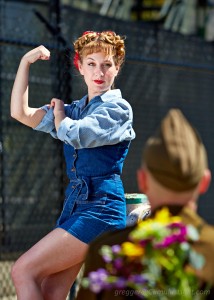Twelve Nights, Six Actors: A Review of TWELFTH NIGHT at the Arabian Shakespeare Festival
November 8, 2018 § 3 Comments
Shakespeare’s plays are undoubtedly great literature, but it is easy to forget that they are also amazing acting machines. The Arabian Shakespeare Festival’s current Twelfth Night is so full of virtuoso performances, including some very unexpected casting and doublings, that I am reminded again that when you bet big on the actors, small is beautiful.
This is ASF’s first foray into Shakespeare’s comedies, after a series of performances of tragedies I admired–especially a conceptually brilliant Othello in 2014. I was not sure how their house style and mission might adjust to this switch. Any doubts I might have had were almost instantly swept away by the sheer joy of playing exhibited by the charming, versatile and skillful cast of six.
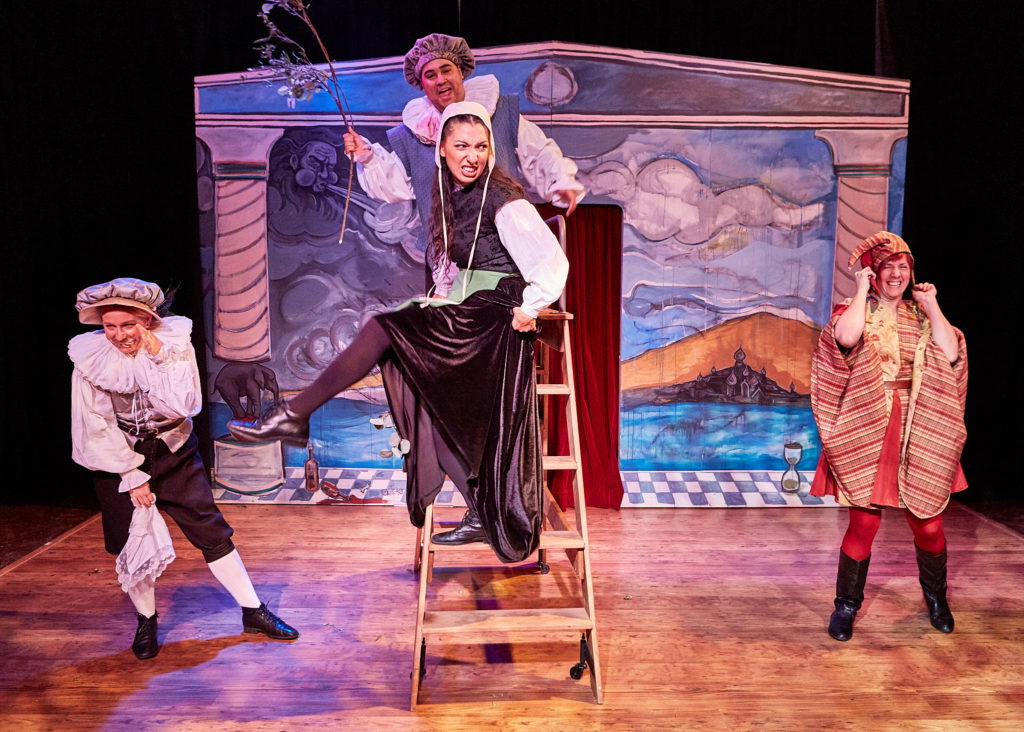
(l to r) Sir Andrew (Jennifer Le Blanc), Sir Toby (John R. Lewis), Maria (Livia Gomes Demarchi), and Feste (Rebecca Pingree) celebrate as their schemes come to fruition, in Arabian Shakespeare Festival’s production of Twelfth Night.
Layers of Delight
Twelfth Night is one of the middle comedies, with twenty roles in the cast list. I’ve seen wonderful productions of the play that were produced with a one actor/one role casting scheme. In these, the bittersweet story of a pair of separated twins (each believing the other lost at sea) who slowly work their way back to a reunion, the overthrow of a puritanical steward standing in the way of pleasure, and the surprising manner in which the courtship of a grieving countess by an admiring Duke ends in happily in marriage–just not to each other, was always satisfying. That is one layer of delight and it can be enough, in and of itself.
ASF’s production, insightfully designed and directed by Audrey Rumsby, sounds all those notes, but it has many more layers in play that make it much more than the sum of those parts.
Rumsby’s set design, echoing the central prop in the play, a toy theatre/music box, turns the Royce Gallery’s tiny playing space into a virtue. We know from her concept that we are seeing an imaginative romp. It invites us to think of the play as literal “play,” a game in progress. Elizabeth Smith’s whimsical costume designs capture the essence of each character, which is crucially important since actors quickly switch from one role to another with additions or subtractions of only a piece or two.
Thou Art Translated!
The cast uniformly delivers on the promise of this premise! John R. Lewis is a dignified and outstanding, if unconventional, Duke Orsino, but with the addition of a big, winestained ruff he transforms into Orsino’s antipode, the perfectly-named drunken reprobate, Sir Toby Belch. Watching him switch back-and-forth is enchanting above and beyond anything that he does in either role–a layer of pleasure that you don’t get in a conventional staging.
Rebecca Pingree raises the bar higher in her main role as the jester, Feste, as she demonstrates some serious musical chops in addition to her acting skills. (The whole production, in fact, is filled with excellent live music performed by the cast, under the musical direction of Lindsey Schmeltzer.) Very early on she doubles the usually forgettable role of the unnamed “Captain” in a surprisingly convincing masculine portrait, but reserves her comic firepower for a thoroughly confused (and confusing) priest in the play’s finale. She is terrific in all three parts.
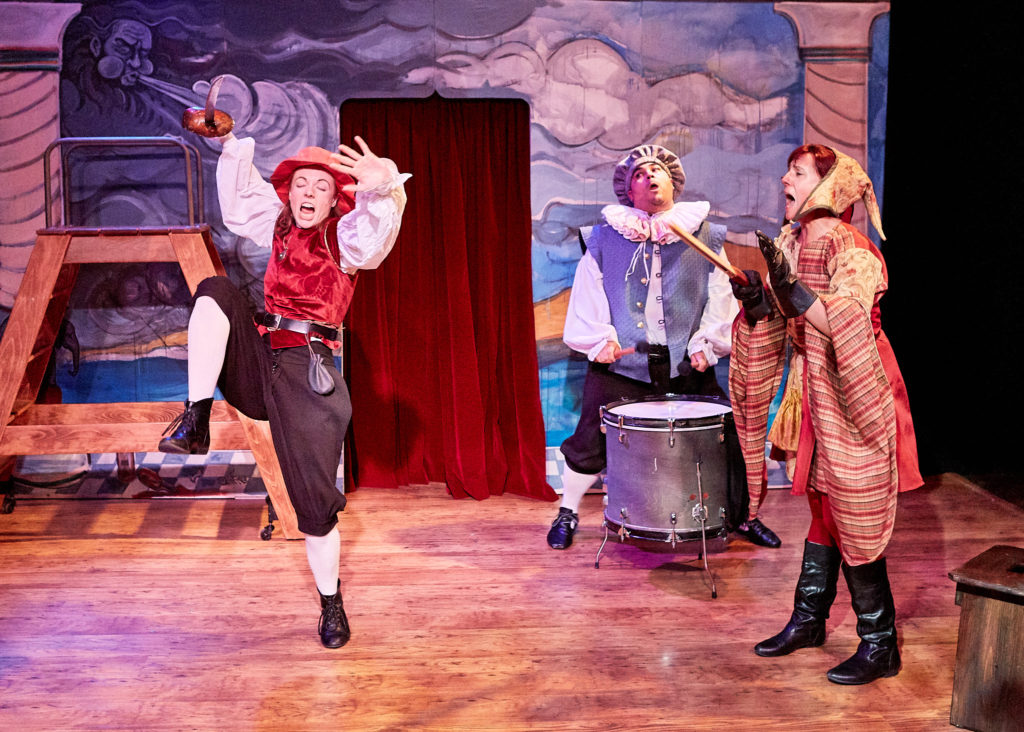
(l to r) Viola (Kate Rose Reynolds) prepares to fight a duel with Sir Toby (John R. Lewis), as Feste (Rebecca Pingree) look on.
Amelia Adams grounds her portraits of the male twin, Sebastian, and the insufferable puritan Malvolio in the physical techniques of Commedia dell’Arte. Neither role is realistically convincing, nor meant to be. (ASF could have cast a male actor, after all, if that was the goal.) Instead, both parts are suffused with deep observational insights about how we construct “leading men” and “the authority of male privilege” that can only be conveyed to an audience when they are obviously put on, instead of inherent in the actor.
Livia Gomes Demarchi plays two female roles at opposite ends of the “leading vs. character women” spectrum. As the Countess Olivia she is proud in declining the proffers of love from Duke Orsino but reduced to a quivering jelly in the presence of “Cesario,” whom she adores without realizing she is pursuing a disguised woman. As Maria, the pragmatic, scheming lady-in-waiting she is almost unrecognizable as the same actress although all that has really changed is the addition of a bonnet.
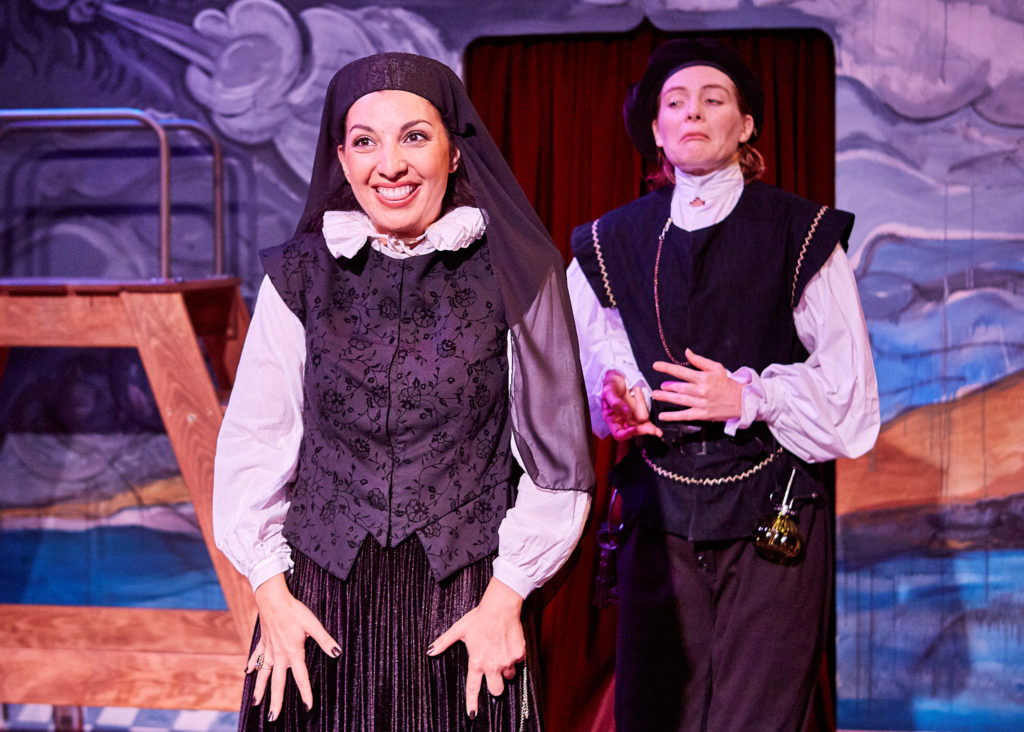
(l to r) Olivia (Livia Gomes Demarchi) reflects on her first meeting with Viola to her puritanical steward, Malvolio (Amelia P. Adams)
Kate Rose Reynolds plays the afore-mentioned twin-in-disguise, Viola/Cesario, (in both her female and male forms) with panache. This is the only “doubling” built into the play, and if it is unsurprising, it is no less entertaining because we see it in the context of a whole shape-shifting cast. I’ve seen an awful lot of “Cesarios” whose entire characterization appeared to be wearing a hat, but Reynolds seriously explores the mental transformation of her character when she assumes the male persona for protection. Hers is the most insightful Viola of my experience.
The actor in the announced cast with which I was most familiar previously was Jennifer Le Blanc, whose Desdemona for this company thrilled me. I was so disappointed to see that she would be playing two minor parts, neither of which seemed to me to make particularly good use of her talents: Sir Andrew Aguecheek, and the dedicated (probably lovesick) protector of Sebastian, the sea captain Antonio. I saved discussion of her performance for last, because I could not have been more wrong. She was astonishing–hysterically funny and heartbreakingly serious by turns–all night long. I found myself desperately racing ahead through the play’s scenes in my mind thinking about how soon I would see her again any time she left the stage. The virtuosity of the performances, of the transformations, and of the ensemble work was exemplary. Above all, her joy in playing the roles was palpable.
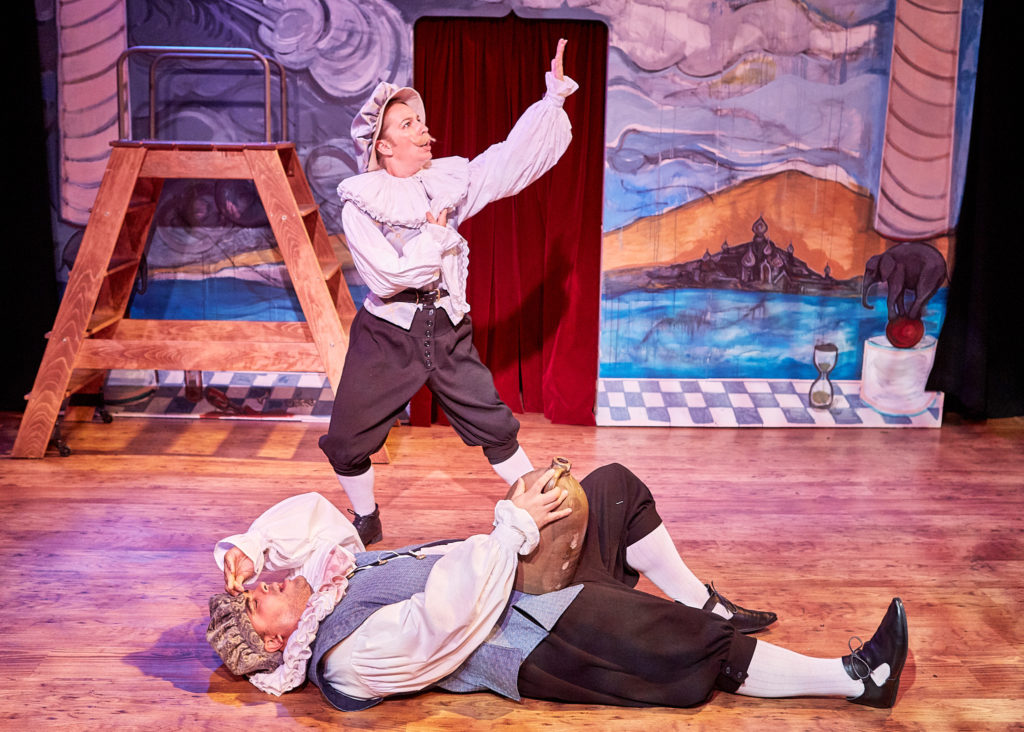
(l to r) Sir Toby (John R. Lewis) and Sir Andrew (Jennifer Le Blanc) drink and celebrate late into the night. All photos by Gregg Le Blanc of Cumulus Light Photography
The Means Are Limited but the Pay-off Is HUGE
ASF’s production is intimate. The space is small. The cast is reduced to just six players. The set and costumes are simple. The means are limited but the pay-off is huge. The play is actually MORE enjoyable because of the imaginative and versatile way that it is produced. I admire this company and have championed their work in the past, but now I have to say that as it matures it improves.
TL;DR
If you love Shakespeare, go see this production. If you love the theatre, go see this production. If you want to deeply understand why Shakespeare is the quintessential theatre artist, do not miss this production! There aren’t many seats. Get one while you can.
More Information
Twelfth Night – Nov.1–18, 2018, By William Shakespeare / Directed by Audrey Rumsby
Royce Gallery – 2901 Mariposa St., San Francisco, CA 94110
Online: www.ArabianShakes.org
By phone: 408-499-0017
This review is of the Sunday, Nov. 4 performance.
The Mask of Blackness: The Arabian Shakespeare Festival’s OTHELLO reexamines Moorishness.
November 15, 2014 § 2 Comments
Otherness comes in many flavors
Since the extinction of the practice of white actors performing (and stereotyping) the title role of Othello in blackface, the play – at least in America – has featured actors of color and become a vehicle for examining black/white race relations. Because that is a necessary, and still unresolved, conversation it has been a highly successful strategy for rediscovering the relevance of the play.
What got lost in that transition is the possibility that Shakespeare was dramatizing otherness and ethnicity, but from a different perspective than Americans are imposing on it because of our current cultural complications: Othello is identified as a Moor, a word more closely associated in the Elizabethan era with those of Arabian descent than with peoples from sub-Saharan Africa. At about the time Shakespeare was writing the play, in fact, Elizabeth was receiving a famous embassy from the Barbary States. The ambassador, who manners and dress captivated London, took time to have his portrait painted.

Abd el-Ouahed ben Messaoud ben Mohammed Anoun (Arabic: عبد الواحد بن مسعود بن محمد عنون) was principal secretary to the Moroccan ruler Mulay Ahmad al-Mansur, and ambassador to the court of Queen Elizabeth I of England
The San Francisco-based Arabian Shakespeare Festival is now producing the play in a version which, unsurprisingly given its mission, opens the conversation about the Anglo/Arab implications of the play. The eight-person cast, led by Armando McClain, is mostly composed of accomplished regulars with various troupes in the active Bay Area Shakespeare scene.
The company is an emerging group, still producing on a shoe-string – albeit in an Equity approved project. Performing currently in the Royce Gallery’s intimate space, (the production will later tour to the United Arab Emerates, I think) the set is a modern adaptation of an Elizabethan open stage, cleverly incorporating two large support pillars into the downstage location similarly occupied in the Globe. The scenery, by Janny Cote, consists of a few sliding cubes and a couple of curtains. (These were hung from an incongruously omnipresent palm-ish tree, center stage, which may allude to the symbol of the desert tribes, but because it lacked any direct purpose was – at least to me – confusing.) Joanne Martin’s costumes were suits and uniforms for the male characters, dresses with prominently featured head scarves for the women. The time and place was the modern Middle East.
Performing in an American/Arabian Context
Kevin Hammond’s direction is understated, and as far as creating visually interesting groupings of the actors, essentially absent. The production, therefore, hangs on the performance of the actors, and on the inescapable contemporary implications arising from the company’s American/Arabian context.
On the performance front, the production is an unmitigated treat. In almost any production McClain’s beautiful vocal production and outstanding diction would stand out, but Teddy Spencer as Iago, Jennifer Le Blanc as Desdemona and Artistic Director William J. Brown III as Roderigo easily kept pace. This was far and away the best-spoken production I have recently experienced. For those who go to hear a Shakespeare play, this is what you dream about. The intelligence of the readings, the clarity of thought, and the easy audibility made this production as accessible as any contemporary play. There was never a moment I felt in doubt about what had been said or what was meant.
Spencer’s Iago is especially rewarding. He is a meticulous actor. I previously admired his performance as Orlando in Marin Shakespeare’s As You Like It for its extraordinary clarity, but his Iago is on another plane altogether. The steps by which his plot unfolds, exceeding even his expectations, are so carefully executed that you can feel him thinking in front of you. His Iago is colder than is currently fashionable, which is interesting in the context of Red State America’s xenophobia – he feels no need to seduce us into agreeing with him. Although Spencer is capable of incredible charisma on stage, he does not seek to charm us in this role. Instead, he steadily implicates us in his plot with an expectation that we will share his hatred of the outsider – which is chilling.
Le Blanc is very well known in the Bay Area. Her Rosie-the-riveter-inspired Kate in Taming of the Shrew at Livermore Shakes (opposite McClain as Petruchio) was a powerhouse performance. She is an unusual Desdemona because she is anything but delicate, or helpless. She is a strong actress, and it infuses her characters. Her Desdemona’s fate forces us to think about the issues of women’s rights both domestically and internationally because she is not passively complicit in it. She fights right to the end.
Perhaps the single best performance in the play is Brown’s wonderfully inept Roderigo, whom Iago dupes financially and ultimately murders. From the opening moments he is in over his head, but Brown’s embodiment of his bewilderment, fear, and pliability is a tour de force. It is exceptionally difficult to play weak characters memorably, but Brown’s Roderigo is the best I have ever seen.
Annamarie MacLeod rounds out the principals as Emilia, Desdemona’s servant and Iago’s estranged wife. Emilia has one of the most memorable monologues in Shakespeare, rationalizing why women might cheat on their cheating husbands, but MacLeod delivered it with a vulnerability and yearning for her lost husband that I have never previously seen.
The supporting cast included Malcolm Rodgers, Aaron Kitchin and Sofia Ahmad all of whom had some lovely moments.
A Fresh Context
Conceptually this is not an aggressive production. While the play itself focuses attention on Othello’s outsider status, the implications of the Arabian context in our current climate (where Arab-Americans can be subjected to intense hostility no matter what their religious beliefs or degree of assimilation) unfold subtly and slowly. I, at least, have seen the play so often filtered through the lens of the African-American experience that it took a while to realize exactly how this production was filtered through the American-Arabian lens instead. (There is neither denigration or dismissal of the former in this production, it is simply seen – unusually for our time – through the latter.)
Nonetheless, it gives the play a different feel and focus. For example, near the end of the play Othello receives word that he has been reposted, creating an urgency in his mind to deal with his (in his belief) unfaithful wife before the opportunity passes him by. He might have dealt with things more slowly and rationally if he were not being transferred the next day. And to where? I never really paid attention before, that his transfer is to Mauritania, from which the word for his ethnicity, Moor, is derived. Venice is rewarding his outstanding service by exiling him to a remote outpost where he will “fit in” now that they no longer need him.
Or this: Desdemona introduces the prophetic “willow song” by telling us that her mother’s maid sang it on the night she died. The maid’s name was Barbary – she was Moorish from the Barbary Coast. The number of references to Arabian matters and frameworks is astonishingly high once they are highlighted by design or by context.
Of course, throughout the play many characters (including Othello, himself) also comment on his blackness. This can be understood symbolically, but it has been a long time since I saw an Othello who was not also very dark skinned, so I have hear these references literally instead. (The last Othello I saw who was not very dark skinned was probably Patrick Stewart in a famous “photo-reversed” production for the Shakespeare Theatre in Washington, D.C. in the mid ’90s where everyone else in the cast was African-American.)
I have no idea how Armando McClain self-identifies ethnically, (nor do I think he – or any actor – has any obligation to clarify such matters) but in this production he reads more bronze than black. In this case, that helped me to hear the production as emphasizing the metaphor, the “mask” if you will, of blackness instead of the literalness so often associated with Othello’s and others’ statements. It was useful and interesting to think freshly about the association of darkness with malignancy and the damage done by such connotations.
This is a fascinating and original production of a play which has grown somewhat interpretively stale in the repertoire, and worth the time and effort of anyone that wants to see and hear it with fresh appreciation. It has a short run, and a limited number of seats, so go while the opportunity is available!
Othello
Arabian Shakespeare Festival at the Royce Gallery
Nov. 14, 2014
www.arabianshakespearefestival.org
Review: TAMING OF THE SHREW at the Livermore Shakespeare Festival
July 1, 2013 § 1 Comment
As Director Gary Armagnac disarmingly admits in the notes to his production currently running at the Livermore Shakespeare Festival, The Taming of the Shrew is now a “problem play.” In its time, it was a lightweight comedy about the battle of the sexes won only when the man showed his independent-minded bride some tough love and put her in her place. To play it that way now just reads as painfully misogynistic. If it were not by Shakespeare, it is entirely possible it would be dropped from the repertoire but because it is, the problem now is to figure out how to find something deeper in it. Like any good puzzle, it now has to be “solved.”
Conceptually, Armagnac goes a long way toward rehabilitating Shrew by setting his “Rosie the riveter” production just after the end of World War II, as the troops return home. Petruchio, the protagonist, is portrayed (along with the other male characters) as anxious to get married, settle down and get on with Eisenhower-ifying America – but the women they are coming home to are not the girls they left behind. Armagnac’s resetting highlights the greater social empowerment women felt (and were in danger of losing) from supplying the home work force while men fought the war. That goes a long way to explaining why Kate, the “shrew” of the title, resists with such vitriol the bevy of suitors who want her bucks but not her pluck.
It is the psychologically insightful portrayals of the quarreling couple by Armando McClain and the simply wonderful Jennifer Le Blanc that make it all work. As Petruchio, McClain’s best moment is the soliloquy in which he asks directly if anybody has any better ideas than he does for taming his wife. Although the speech is an extended metaphor about falconry, through subtext he reveals that the only methods this returning army captain has in hand are the ones he used to discipline his troops, and he rightly worries about their current appropriateness.
Le Blanc, who both looks and sounds like a young Helen Hunt, showed us right from the start that the issue was not that she hates men, but that she loves – and fears losing – the scope of her unfettered life. Astonishingly, she somehow never lets us forget she is balancing her genuine fondness for the handsome and confident Petruchio with the desire to retain her independence, including in many scenes where the text has much less substance.
Not that fidelity to the text was much of an issue in the production. Armagnac’s other main conceptual innovation was setting the play right in the very California vineyard where it was being performed, which succeeded in incorporating the beautiful natural setting and led to some very clever moments. (A servant summoning Kate just stuck her head out a second story window and bellowed into the field, from which a grumbling Kate emerged with pruning implements still in hand.)

The mansion on the grounds of Concannon winery that serves as a permanent backdrop for the Livermore Shakespeare Festival
Less successfully, it also meant that all references to Padua were changed to Livermore, Pisa to New York, and from there the floodgates were opened. Horses became jeeps, servants became soldiers, and actual welcome home speeches from the war were inserted into the play. Although resetting the play into a period of rapid, and unsettled, social transformation (not unlike our own) was revelatory, the text was shoehorned into its new shape, and where it would not stretch to fit, just changed wholesale. In previews, many of the biggest laughs from the audience were not at the play’s humor, but at the incongruity of the very unShakespearean inserted material.
The best moments in the production came not from alteration, but from honest delivery of the plot in its new context. Patrick Moore, who already gave one outstanding performance this summer, portraying a loving father in The Liar (the repertory’s other production) delivered again here. As Baptista, he desperately tries to balance the happiness of both his daughters. He is quite moving during Kate’s wedding scene fearing that he’s made a mistake by hastily accepting the mad-seeming Petruchio as her husband to clear the way for Bianca. Rebecca Pingree, another terrific performer cast in both productions, played the minor role of the widow that a suitor must settle for when a rival outmaneuvers him for Kate’s younger sister, Bianca. Pingree brought illuminating gravity to the play’s final scene by playing the widow not as the typical doddering old woman, but as a young girl whose husband was lost in the war.
At least in its final preview, this was a production with an admirable aim that exceeded its grasp. However, with excellent and deeply felt performances from its leads, as well as from the afore-mentioned Pingree and Moore, it still managed to speak to contemporary concerns: it showed us two people negotiating a new kind of relationship in the absence of societal models for doing so. That is a lot to wring out of Shrew.
The production would have been stronger if it had remained faithful to this more serious reading throughout, but the subplots were less carefully considered, and overstuffed with tacked on lazzi. Genuinely successful comic moments were, however, provided by Brian Herndon as an Ensign Pulver-like Tranio, and Jeremy Tribe-Gallardo (an intern with a big future coming) as the funniest Grumio I’ve ever seen.


